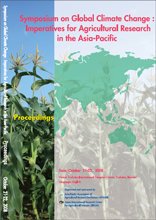Mitigation Potential and Opportunities in Asia-Pacific

Adapting to climate change implies choice of soil and crop management practices to make appropriate
adjustments in farming operations with regards to increase in soil temperature, decrease in plant
available water, change in the growing season duration, increase in soil erosion hazard, etc. (Lal,
2004; Lal, 2008a). In comparison, mitigation options involve choice of land use and soil/crop
management practices which would either reduce emissions or sequester emissions. Emission
reduction strategies include those which avoid deforestation, reduce soil erosion, minimize losses of
fertilizers and pesticides, and make soil a net sink for atmospheric CO2 and CH4. Most agricultural
soils have lost 30 to 50 t C/ha due to past land use and management based on extractive farming
practices (Lal,2004). The soil C pool can be increased by restoration of degraded/desertified soils
through afforestation and reforestation, improving degraded pastures, rehabilitating
polluted/contaminated soils, and adopting recommended management practices (RMPs) on
agricultural soils to create positive C and nutrient budgets and conserving soil and water. Among
RMPs are no-till farming with crop residue mulch and cover cropping, integrated nutrient
management (INM) along with judicious use of fertilizers including slow release formulations,
conserving water in the root zone, and adopting complex cropping and farming systems (Lal, 2008b;
2009). The rate of C sequestration ranges from 500 to 1500 kg/ha/yr in soils of cool and humid
climates, and 100 to 500 kg/ha/yr in those of warm and arid climates. In addition to organic C, soil C
sequestration also occurs through formation of secondary carbonates (pedogenic carbonates) in arid
and semi-arid climates and through leaching of bicarbonates in soils irrigated with good quality water.
The rate of formation of secondary carbonates is 2 to 20kg/C/ha/yr, and is important at the geologic
time scale. Removal of crop residues, for biofuel and/or grazing as well as biomass burning, creates a
negative C budget and depletes soil C pool (Wilhelm et al., 2004). Soil degradation by erosion and
other processes also depletes C Pool and exacerbates emissions (Lal, 2003). Contrary to the claim by
sedimentologists (Van Oost et al., 2007; Stallard, 1998), soil erosion emits about 1 Gt C/yr (Lal,
2003). The potential of C sequestration is about 1 Gt C/yr in soil of each of the croplands,
grazing/range land, degraded desertified soils and ecosystems. The global potential of these 3
terrestrial ecosystems(~3GtC/yr) is equivalent to withdrawing about 50 ppm of atmospheric CO2 over
50 years. In addition to mitigating climate change, soil C sequestration is also essential to advancing
food security (Lal, 2006). Adoption of RMPs is developing countries to sequester C in soils at the rate
of 1tC/ha/yr can increase food production by 30 to 50 millions t/yr (Lal, 2006), enough to fulfill the
food deficit especially in Sub-Saharan Africa. It is a truly win-win situation, and a bridge to the future
until low-C or no-C fuel sources take effect.
| 刊行年月日 | |
|---|---|
| 作成者 | Rattan Lal |
| 著者キーワード |
Global warming soil restoration soil C sequestration no-till farming food security |
| 公開者 | Japan International Research Center for Agricultural Sciences |
| オンライン掲載日 | |
| 号 | 2008 |
| 開始ページ | 42 |
| 終了ページ | 55 |
| 権利 | Japan International Research Center for Agricultural Sciences |
| 言語 | eng |
